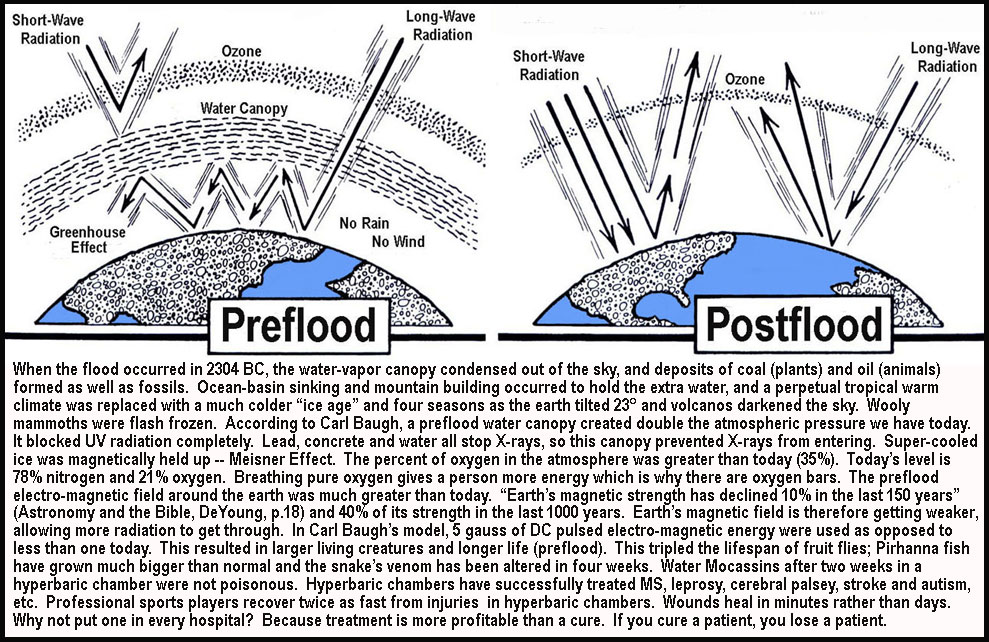The Pre-Flood World
A 50-inch-wingspan dragonfly fossil was found in Italy. Today they are limited in size by the amount of oxygen and the air pressure. They breathe through their skin. Bugs growing in oxygen-rich waters grow "up to 1000 times heavier" than those living off Europe! If an animal increases in size, it has less surface area compared to its volume. This is why huge insects can't breathe in today's atmosphere. But fossil insects are huge. Cockroaches over 18 inches long have been found in the fossil record. A fossil centepede 8.5 feet long was found. Fossil grasshoppers have been found over two feet long. A giant tarantula fossil was found with a three-foot leg span. Fossil cattails have been found 60 feet tall. a donkey was excavated near Lubbock Texas that was 9 feet high at the shoulder. Fossil buffalo horns have been found with a 12-foot span. Giant elk with 12-foot antlers. Kangaroo fossils have been found that are ten feet tall. A wombat the size of a Mini Cooper. A giant pre-historic goose stood as tall as an elephant and weighed up to half a tonne. Fossil beavers have been found over 8 feet long. Salamanders grew 6 feet long. Sharks before the Flood were 80 feet long. Turtles bigger than men. Oyster shells have been found on the tops of mountains of Peru two miles above sea level 11.5 feet wide. Fossilized birds (Dinornis Maximus) have been found 13 feet tall. Reptiles never stop growing. They grow throughout their entire lives (Holt Earth Science, 1991, p.293). Dinosaurs are just big lizards.
Life on Planet Earth Before Noah's Flood
A key to understanding the Pre-Flood Earth is the existence of a canopy of water in the stratosphere. In the Genesis Account of Creation, we read: Genesis 1:6-8, 'Then God said, "Let there be a firmament in the midst of the waters, and let it divide the waters from the waters." Thus God made the firmament, and divided the waters which were under the firmament from the waters which were above the firmament; and it was so. And God called the firmament Heaven. So the evening and the morning were the second day.'
The Firmament (now known as the sky)
The "firmament" is not a word which we now use, so we need to look carefully to see what God is talking about. Fortunately in Genesis 1:20 it becomes perfectly clear: "Let birds fly above the earth across the face of the firmament of the heavens." So the "firmament" is the sky, where the birds fly. In other words, the sky appeared between the water above the sky, and the water below the sky. After the appearance of the firmament there were three separate layers:
Region 1: Water in the stratosphere.
Region 2: The sky, where the birds fly.
Region 3: Water below the sky, now known as the sea
There was therefore, at the original Creation, a water canopy in the stratosphere, above the sky (the firmament).
After Noah's Flood this water canopy in the stratosphere was removed, and the water became part of the waters of the Flood of Noah, approximately 4,400 years ago. The water canopy in the stratosphere is therefore no longer present. The water canopy originally provided protection against cosmic radiation from outer space. The Water layer in the Stratosphere had several very important functions:
Warm temperature and greenhouse effect
The temperature was probably much warmer, with no variation of temperature over the entire planet because of the "greenhouse effect" of the vapour canopy in the stratosphere. This perhaps explains why Mammoths preserved in the permafrost in Siberia have tropical vegetation in their stomachs.
Blocking of dangerous X-rays and ultraviolet radiation
One of the very important functions of the upper atmosphere today is that much of the dangerous radiation from the sun is filtered out. However, some dangerous radiation still gets through to the surface of the Earth. This is why, for example, overexposure to sunlight can cause skin cancer.
The blocking of dangerous X-rays and gamma rays would probably have been much greater before the Flood. This probably accounts for the much longer life spans of the patriarchs recorded in the Bible (over 900 years).
Consider these points:
Genesis 2:5-6 indicates that at least prior to the creation of Adam, rain did not fall but that the plants were nourished by springs coming up out of the ground. The Bible does not actually mention rain until the Flood, and a canopy by providing a greenhouse effect could have lessened the need for the water cycle. If Noah was the first person to see a rainbow, that would add further strength to the canopy theory.
Gen. 7:11-12 tells us it rained for forty days and nights. Such a lengthy deluge would be impossible today because there isn't nearly enough moisture in the present atmosphere; therefore, there had to be much more water in the heavens of Noah's time.
Many ancient cultures have legends that seem to describe a canopy-type phenomenon. For example, the Babylonian creation account, Enuma Elish, mentions fog, clouds, or mist covering the early Earth.
Such fossils as palm trees in Alaska, crocodiles in New Jersey, and petrified wood in the desert suggests a warmer climate in the past and perhaps a more uniform worldwide climate which a canopy might have provided. Although Genesis mentions seasons in relation to the creation of the heavenly bodies, summer and winter seasonal heat and cold as such are not mentioned in Scripture until after the Flood.
A canopy would have provided an increased atmospheric pressure, heavier air in other words, that would have allowed the prehistoric flying reptiles such as the pteranodon to have taken flight. It is doubtful that these creatures would be able to fly in today's thinner atmosphere (see just below).
A canopy might be the answer to the long ages of the early humans as well as the giantism found in some plants and animals in the fossil record (see below). The canopy would have absorbed much of the harmful radiation that is known to have damaging effects on organisms. With less radiation reaching the surface of the Earth, living things could have lived much longer and in the case of some species, grown to giant sizes. Also, increased air pressure and oxygen would have been beneficial.
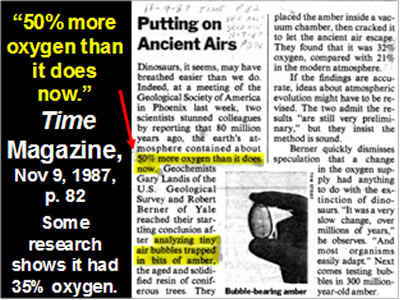  
Richer oxygen and carbon dioxide in the Atmosphere
The water canopy in the stratosphere would have dramatically increased the partial pressure of gases on Planet Earth, causing 50% higher concentrations of Oxygen and Carbon Dioxide. This is proved in experiments on Pre-Flood air trapped in fossilised tree sap, now known as the semi-precious stone, Amber.
According to experiments recorded in Time magazine the partial pressure of Oxygen in the atmosphere was at one time 50% higher. According to Time Magazine the oxygen content in Amber is 50% higher than it is now, (see Time Magazine, Nov 9, 1987, p. 82).
Amber is a semi-precious stone, commonly used in ladies' jewellery. Amber is actually fossilized tree sap, and frequently contains either insects, or bubbles of air. According to Time Magazine November 9, 1987, p. 82, bubbles of air in Amber have an oxygen content that is 50% higher than the present atmospheric air. According to this article in Time Magazine, Geochemists Gary Landis of the US Geological Survey and Robert Berner of Yale analyzed tiny air bubbles trapped in specimens of Amber. They placed the Amber specimens inside a vacuum chamber, and then opened the Amber, allowing the ancient trapped gases to escape. They found that the air contained 32% oxygen, which is much higher than our current 21% oxygen content in the atmosphere. This finding is confirmed in The New Scientist Magazine published on March 11, 2000. According to this article the air trapped in Amber has 35% oxygen. These findings confirm that Planet Earth had much higher Oxygen and Carbon Dioxide levels at an earlier date, and would seem to confirm the theory about higher Oxygen and Carbon Dioxide levels in the atmosphere, caused by the water canopy before Noah's Flood.
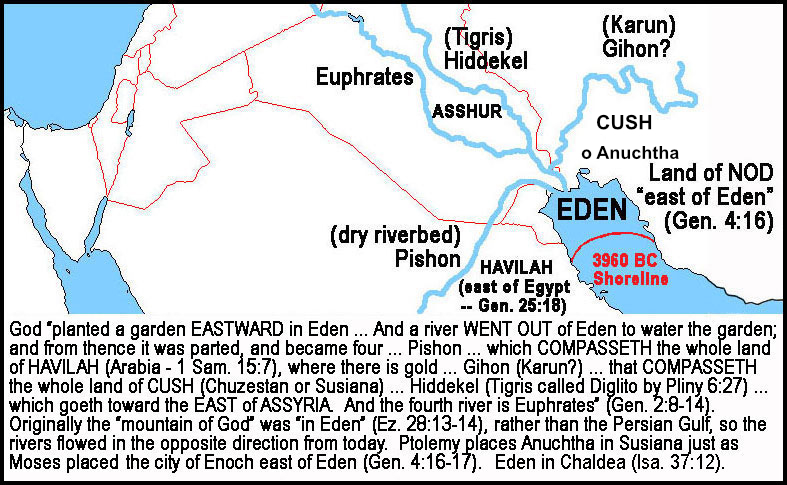 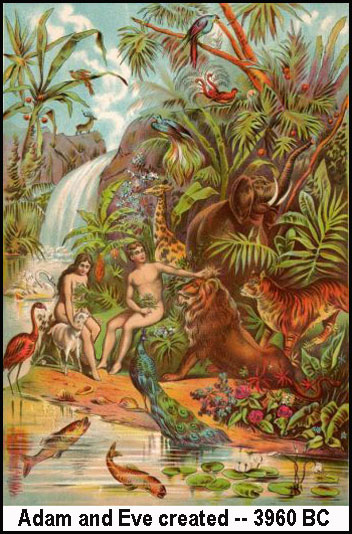 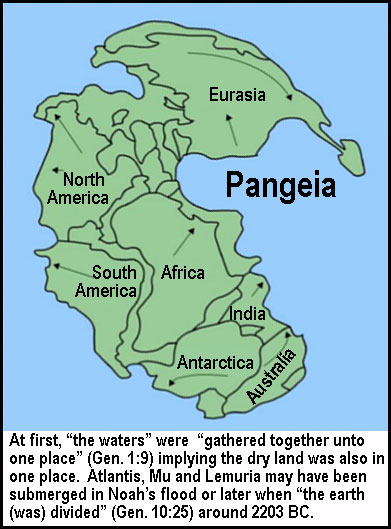
Benefits of the warm temperature, high oxygen content and lack of dangerous radiation in the pre-flood Earth. The Garden of Eden conditions described in the early chapters of Genesis were probably reflected all over the planet. There was probably abundant vegetation, animals, birds and fish. Because of the warmer and more constant ambient temperature, and the high partial pressures of Oxygen and Carbon Dioxide humans, animals, birds, insects, and fish were much larger, as revealed in the fossil record described below. There is a general teaching that early man was primitive. This is certainly incorrect. Adam and Eve were created in the image of God, and actually would have been superior to us in every way. Think about it: These two individuals held all of the genes that have been passed down through all generations until you and I.
Because of the protective effect of the water canopy, there was protection from damaging ultraviolet rays and gamma rays, with probably much lower incidence of consequent diseases such as cancer and foetal malformations. Because of the higher oxygen levels, the high blood oxygen levels would have contributed to extreme longevity, resistance to bacterial and viral diseases, and greater metabolic efficiency, with consequent greatly enhanced athletic ability. The average age of man before Noah's Flood was 912 years. Today it is 70- 80. The average recorded life span in the Bible of the early patriarchs is 912 years. This is in stark contrast to today's much shorter life spans, with 70 -80 years being typical. This may be accounted for by the higher oxygen content, the protective effect of the water canopy, lack of disease, better diet, and much less hostile weather patterns.
 
Giants in the Bible
The Bible describes giants, before and after Noah's Flood. It is recorded in 1 Samuel 17:4 that Goliath was six cubits and a span tall, which is approximately nine feet tall (one cubit is approximately the distance from your elbow to finger tip). The Bible records, in Deuteronomy chapter 3:11, that the iron bed of Og, King of Basham, was 9 cubits by 4 cubits or approximately 14 feet long by 6 feet wide.
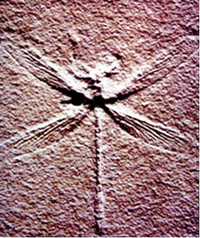  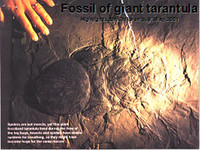 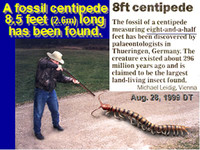 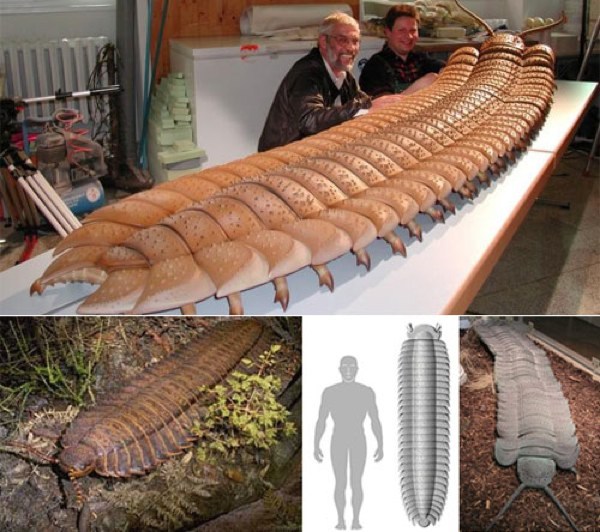
Fossil Evidence of Huge Insects, Giant Dragonfly, Giant Tarantula, Giant Cockroaches, Giant Centipede, etc.
Insects breathe oxygen through spiracles in their skin. Their size is limited only by the amount of oxygen available. In the high oxygen Pre-Flood atmospheric conditions, insects grew much larger.
This fossilised dragonfly was discovered in Italy with a 50 inch wingspan ( see www.creationevidence.org). This Pre-Flood dragonfly was buried under tons of rock, instantly fossilised at Noah's Flood 4,400 years ago. A fossil of a giant tarantula spider about 18 inches long has been discovered. This Pre-Flood tarantula spider was buried under tons of rock, instantly fossilised at Noah's Flood 4,400 years ago. Cockroaches over 18 inches long have been found in the fossil record. They would have been unpleasant pests in the kitchen! A fossil of a centipede eight and a half feet long has been discovered by palaeontologist in Germany. This Pre-Flood centipede was buried under tons of rock, instantly fossilised at Noah's Flood 4,400 years ago. Pliny relates from Livy, that when Regulus commanded the Roman forces in Africa, he was infested by a serpent 120 feet long, and so invulnerable, its scales being impenetrable, and its breathe so infectious, that he was forced to use the military engines, which they used against towers, and the walls of towns, before they could subdue it; and says, the skin of it was hung up at Rome, and remained there until the war with Numantia (about 100 years) (Pliny Natural History 8:14; Livy History 18:15-16) And the same naturalist speaks of serpents 20 cubits long in other places (Natural History 31:2:15) and of so large a size as to draw away oxen and stags whole (8:14). Since subduing a serpent was one of the labors of Hercules, this implies great strength needed (Apollodorus 2:4:2; Mart. Ep. 9:104).
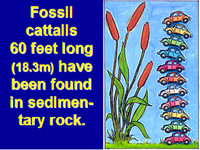
Fossilised Giant Vegetation
Fossilised cattails 60 feet high have been discovered in sedimentary rock. In the Pre-Flood atmosphere the Carbon Dioxide content was much higher because of the canopy of water. This high Carbon Dioxide content caused the cattails, and all vegetation, to grow much larger, and also more abundantly. Even today tomato plants grown in artificially created atmospheres in greenhouses with high Carbon Dioxide content produce very large crops of tomatoes.
Vegetation before the Flood was superabundant, with extremely large trees, fruit, and vegetables. It was truly superabundant vegetation, all over the world. During the Flood, the huge forests were rapidly compressed under tons of rock, forming our huge coal seams all over the world. Coal can be artificially created today by compression of vegetable matter. We believe that animals and fishes were compressed at the time of the Flood to form the huge oil reservoirs. All of this God did by the great Flood, creating all of the oil, gas and coal and other minerals.
 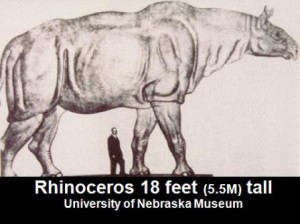   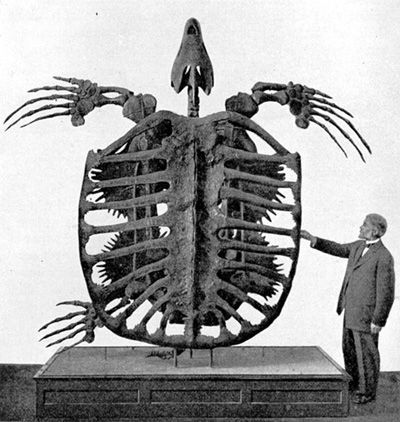
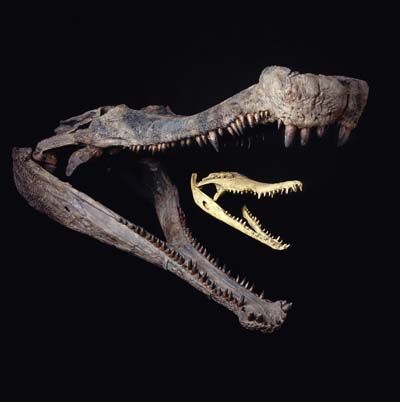 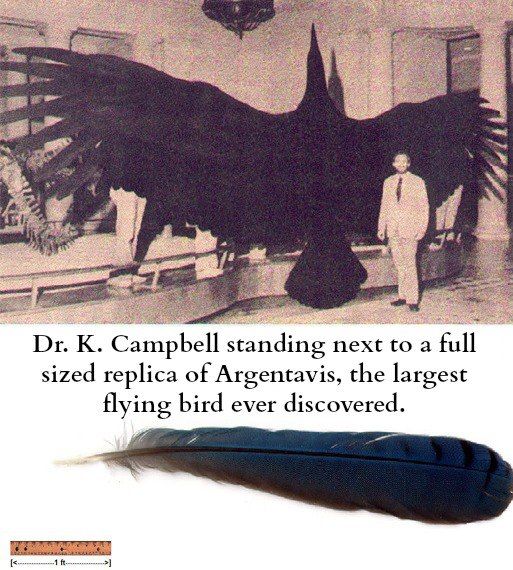 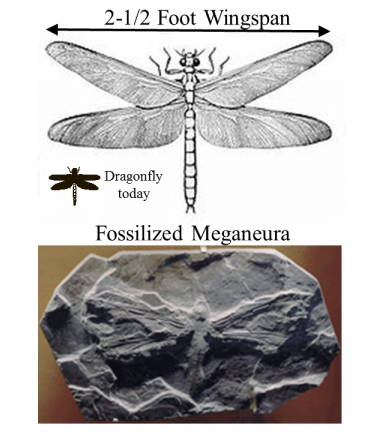
Giant Buffalo, Rhino, Donkey, Beaver, Turtles and Crocodiles
A fossilised buffalo horn with a 12 foot span has been discovered, and is in Dr Baugh's museum in the USA. This Pre-Flood buffalo was buried under tons of rock, instantly fossilised at Noah's Flood 4,400 years ago. A donkey was excavated in Texas, USA, which is 9 feet high at the shoulder. This proves the existence of giant donkeys.
Fossils of beavers over 8 feet long have been found. These Pre-Flood beavers were buried under tons of rock, instantly fossilised at Noah's Flood 4,400 years ago. The jaw of a beaver 8 foot long has also been found in the USA, proving the existence of giant beavers. This giant turtle skeleton is exhibited at the Yale Museum, New Haven, Connecticut. It is approximately 10 feet high. This is simply evidence that giant turtles existed. Regular-sized crocodile jaws easily fit inside of the giant crocodile jaws.
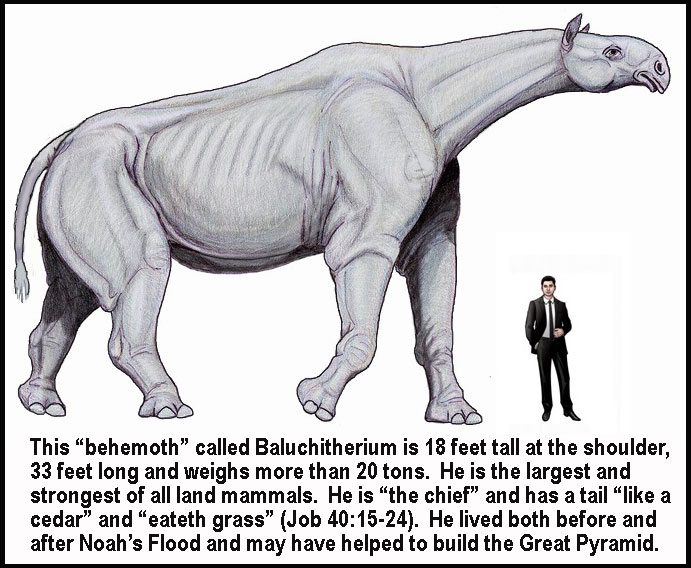
What is the animal called "behemoth" in Job 40:15-24?
Is it the hippopotamus? The elephant? Or some other creature? In 1911 a British scientist found a few HUGE bones from an enormous type of rhinoceros. The bones were so LARGE, they made even
elephant's bones appear small by comparison! He named the animal Baluchitherium. Eleven years later, an American scientist found three partial skeletons of Baluchitherium. The skeletal remains were rushed to New York where they were assembled. The huge beast was confirmed to be an extinct, gigantic, apparently hornless rhinoceros -- a creature which may be the biblical "behemoth" memioned in Job! Then in 1999 a French team discovered a near-complete skeleton. Notice the parallels between the now-extinct Baluchitherium and the creature of Job 40:15-24. Begin with Job 40:15: "Behold now behemoth, which I made with thee: he eateth grass as an ox." God created plants, including grass, and animals for the benefit and pleasure of man. The warm-blooded animals and the grasses and herbs were made at the same time as man was made -- about 6000 years ago (Gen.1:24-25).
Notice Job 40:15: "Behold now behemoth, which I made with thee." Here is an animal God made when man was made. Behemoth did not exist in the pre-Adamic world which was filled with giant dinosaurs. Behemoth was a unique animal created with man. Continuing in Job 40:15: "he [behemoth] eateth GRASS as an OX." Grass, remember, did not exist on the earth before man's world was created (Genesis 1:11-12).
Therefore, unless dinosaurs were part of man's world, they are excluded from consideration as candidates for "behemoth." Furthermore, behemoth was not a carnivore. He was an animal which ate grass! This rules out the possibility that behemoth could have been a Tyrannosaurus Rex. Baluchitherium "was an HERBIVORE that stripped leaves from trees" (pakistanswildlife.wordpress.com/2012/12/14/the-beast-of-balouchistan/). Yet,
"He is THE CHIEF of the ways of God: He [alone] that made him can make his sword to approach unto him" (Job 40:19). This rules out the hippopotamus, the elephant, or other creatures men have taken into captivity or killed. It must have been the LARGEST and STRONGEST land animal God made for man's world. The discovery of fossil Baluchitherium fits all these characteristics, as well as the other characteristics of this HUGE animal as described in Job 40:15-24. "The LARGEST MAMMAL that ever lived on land was the Baluchitherium, which stood 18 ft. high at the shoulders. Remains of the animal were first discovered in 1911 by C. Forster-Cooper of the British Museum" (The New Yorker Aug. 14, 1971, p.39).
Job 40:18 informs us: "His bones are as STRONG pieces of brass; his bones are like bars of iron." These facts have been confirmed: "Its limbs were massive and STRONGLY constructed" ("Indricotherium" Britannica.com).
His LARGE tail is truly "like a cedar" (Job 40: 17). The Biblical description of a large tail would also disprove the elephant or hippopotamus as candidates for behemoth in Job 40:15. The hippopotamus has only a short tail -- about a foot long. The elephant has a weak, slender tail. Baluchitherium, on the other hand, has a thick tail about
eight feet long, and is the only known giant animal that approaches the description. Even the habitat of the rhinoceros family -- determined by observing the modern rhinoceros -- fits the description of behemoth's surroundings. Compare the following description from The Encyclopedia Britannica with the Bible's account in Job 40:15-24. "[Rhinoceroses] feed on herbage, shrubs and leaves of trees, and like so many large animals which inhabit hot countries, sleep the greater part of the day" and are most active in the cool of the evening or even during the night. Some are found in more or less open plains, while others inhabit swampy districts" (art. "Rhinoceros," Vol. 23, p. 243, 11th edition).
Why did God make this HUGE animal? Perhaps one purpose was to keep men humble -- especially self-righteous men (Job 32:1). How would YOU feel if suddenly this 18-foot-high beast began to charge at you? But more specifically, why discuss the behemoth in the book of Job? Perhaps because Job employed these animals to perform a task. Such LARGE, STRONG beasts could have easily pulled the HUGE STONE BLOCKS used to build the GREAT PYRAMID and other buildings. The yellow limestone (nummulitic) blocks making up the bulk of the Pyramid average two and a half tons each and are estimated to number about 2,300,000 quarried from ten miles away. This equals nearly 90,000,000 cubic feet of masonry and enough to build 30 Empire State buildings. We think they somehow were able to harness these behemoths -- using them like we use bulldozers, dump trucks, and trackhoes.
"Cheops succeeded to the throne, and plunged into all manner of wickedness. He closed the temples, and forbade the Egyptians to offer sacrifice, compelling them instead to labour, one and all, in his service....A HUNDRED THOUSAND MEN laboured constantly, and were relieved every three months by a fresh lot....The pyramid itself was TWENTY YEARS in building." (Herodotus book 2:124). Since 20 years = 7,300 days = 175,200 hours, then 2,300,000 blocks divided by 175,200 hours = 13 blocks per hour. That is 13 blocks quarried, transported ten miles, shaped and fitted into their final positions in the pyramid EVERY HOUR, day and night, non-stop for 20 years! Of course 100,000 men divided into three eight-hour shifts gives 33,333 men always on duty. If we divide that by 8 hours, we get 4166 men to
deal with those 13 blocks per hour, or 320 men per block per hour.
|
